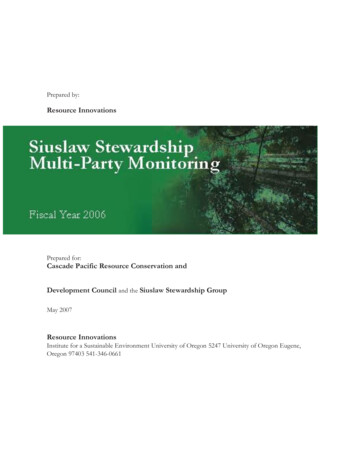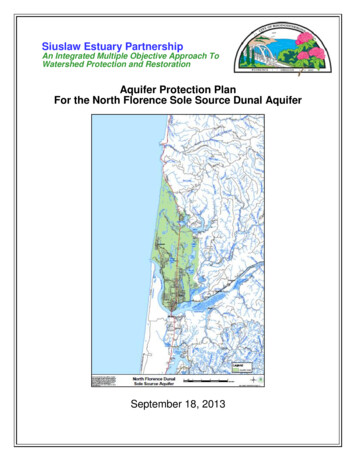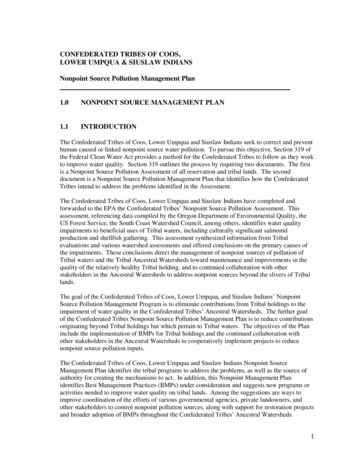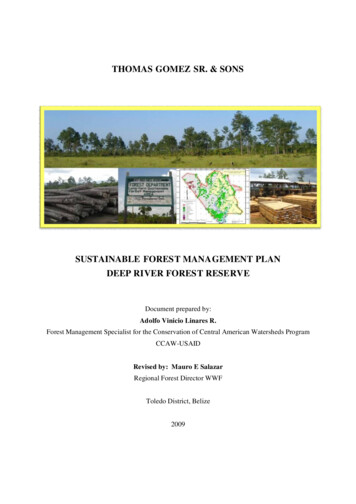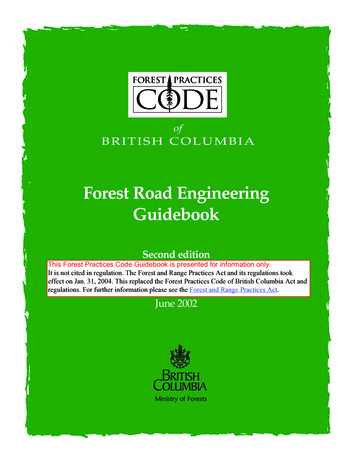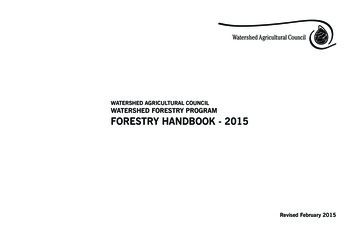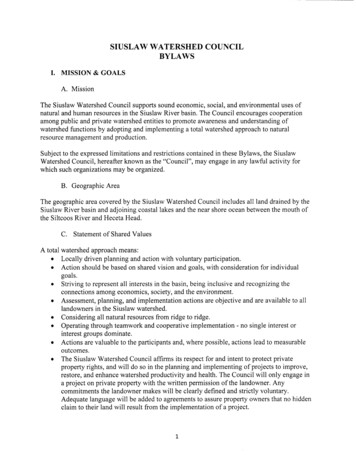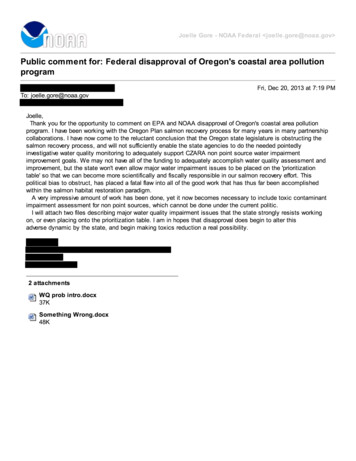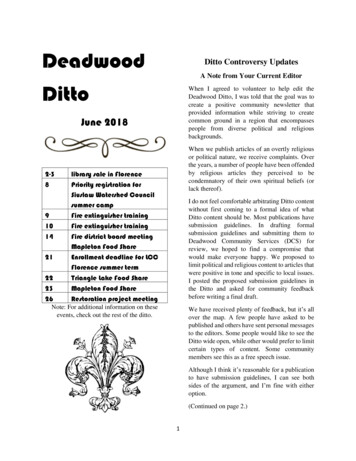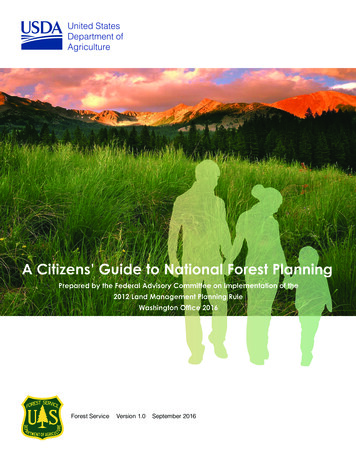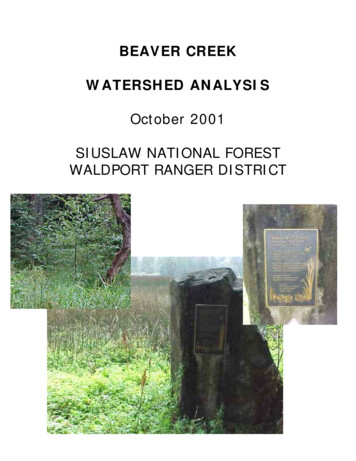
Transcription
BEAVER CREEKWATERSHED ANALYSISOctober 2001SIUSLAW NATIONAL FORESTWALDPORT RANGER DISTRICT
BEAVER CREEKWATERSHED ANALYSISTABLE OF CONTENTSChapter One – Watershed OverviewIntroduction . . 1The Late Successional Forest . .2A Coho Stronghold . .2Location And Size. 2Land Ownership . .4Federal Land Use Allocations . 4The Lower Reaches . . 6Chapter Two – Key Questions, Findings and RecommendationsThe Process. . . 9Issue: Older Forests . .9Key Findings . . .11Recommendations 12Chapter Three – The Watershed AnalysisIntroduction. . . . .15The Physical Environment. . .15The Biological Environment : Aquatic . . 21The Biological Environment – Terrestrial Vegetation . . 30The Biological Environment – Terrestrial Wildlife and Habitats .42The Social Environment . . . 47Chapter Four – Watershed Restoration AssistanceAssistance Available for Restoration on Private Lands 50
List of Maps, Tables and FiguresMap 1: Vicinity . . .3Map 2: Land Ownership . 6Map 3: Presettlement Vegetation . .16Map 4: Lithology and Landslides . 17Map 5: Geomorphic Stream Segments . 18Map 6: Fish Habitat Ratings . 25Map 7: Fish Distribution . .29Map 8: Plant Series . .31Map 9: Current Vegetation . .34Map 10: Fire History . .36Map 11: Swiss Needle Cast Infection, 1999 . . .39Map 12: Interior Forest .43Map 13: Roads and Culverts . 49Table 1: Land Ownership 4Table 2: Land Use Allocation .6Table 3: Management Recommendations . 12Table 4: Stream Temperature data from Beaver Creek Watershed . .21Table 5: Matrix of Factors and Indicators for Key Stream Reaches . .24Table 6: Summary of Climate and Vegetation Influences .32Table 7: Seral Classes by Land Ownership 35Table 8: Fire History . 37Table 9: Swiss Needle Cast Survey Data 38Table 10: Mature and Interior Forest by Ownership. .42Table 11: Culvert conditions in the Beaver Creek Watershed .48Figure 1: Large Wood Values for Selected Reaches .22Figure 2: Pool Habitat Values for Selected Reaches .23Figure 3: Riparian Vegetation Along Steeper Creeks. . .27Figure 4: Riparian Vegetation Along Flatter Creeks . 27
CHAPTER ONE:WATERSHED OVERVIEWIntroductionThe Siuslaw National Forest has prepared this Beaver Creek Watershed Analysis as required withinthe Northwest Forest Plan (NFP – USDA/USDI 1994). The Northwest Forest Plan was developed tomaintain and restore the ecology of federal lands within the range of the northern spotted owl,focusing on older forests (Late Successional Reserves) and watershed health (Aquatic ConservationStrategy – ACS). Watershed analysis is intended to: Provide site-specific information to meet ACS objectives in future project planningProvide the basis for restoration and monitoring programs for terrestrial and aquatic species,Provide the foundation from which Riparian Reserves (streamside zones) can be delineated.This watershed analysis discusses the ecological processes at work in the Beaver Creek watershed,focusing on two resources: older forests and coho salmon. The analysis compares pre-settlement andcurrent conditions, identifies important natural processes, and evaluates human impacts within thewatershed.This watershed analysis generally follows the outline described in the updated Federal Guide forWatershed Analysis - Ecosystem Analysis at the Watershed Scale (Federal Guide - Version 2.2,August 1995). Recommendations for maintaining/restoring natural processes on National Forestlands are included to help guide future project planning. Opportunities for restoration on privateland are also discussed; private landowners and other organizations can use this information tosupport projects outside Forest Service jurisdiction.A watershed analysis is not a decision-making document. Future project planning will use thisdocument as a starting point, however new information, environmental or policy changes, and/orsite-specific conditions could lead to new findings and recommendations. This document should beconsidered iterative; new information will be incorporated as it becomes available.1
The Late-Successional ForestLate-successional forest habitat within the Beaver Creek watershed is recoveringfrom 100 years of agriculture, residential development and logging. Latesuccessional forests currently occupy about 31 percent of the watershed. A very low1 percent of the watershed provides interior (unfragmented) forest habitat.1A Coho StrongholdCoho salmon, a species recently listed as threatened under the Endangered Species Act2, is the singlemost important resource in the Beaver Creek watershed. Beaver Creek has many specialcharacteristics that make it one of the last strongholds on the Oregon Coast for coho:The stream has a high proportion of low-gradient, slow flowing reaches and estuarineareas that are preferred coho rearing habitat.The watershed is relatively intact, with little urban development, low recreational use andmoderate amounts of logging.Beaver Creek has not been heavily fished, and has not had releases of hatchery coho tosupplement or sustain the fishery.These characteristics increase the Beaver Creek watershed’s potential as a refuge that can providestock for native coho recovery in local streams. Federal lands in the North Fork of Beaver Creekare designated as a Key Watershed in the Northwest Forest Plan, making it a high priority formaintenance and restoration of aquatic habitat and species. Lower reaches of the Beaver CreekWatershed are also designated as Critical Habitat for coho.Location And SizeBeaver Creek is a 32,500-acre, 5th field watershed that lies between Yaquina Bay to the north, andAlsea Bay to the south (see Map 1: Vicinity). The mainstem of Beaver Creek reaches the ocean atOna Beach.The Beaver Creek watershed analysis area is divided into seven subwatersheds; three of these draindirectly into the Pacific Ocean, and are not connected to Beaver Creek.1Late-successional forest is a generic term that includes mature conifer forests and old growth. It is usedinterchangeably with the terms “older forests” or “mature forests”.2Endangered Species Act listing is uncertain following recent litigation.2
Map 1: Vicinity3
Named streams that are part of the Beaver Creek stream system include: Peterson, Lewis, Bowers,Tracy, Simpson, Pumphouse, Bunnel, South and North Forks of Beaver, South and North Forks andmainstem Elkhorn, Graves, Worth and Oliver Creeks. Named creeks within the analysis area thatflow directly to the Pacific Ocean include: Thursday, Friday, Collins, Buckley, Fox, Squaw, Hill,Deer, Lost, Thie, Grant and Henderson Creeks. Named creeks are shown on Map 5: GeomorphicStream Segments.Land OwnershipTable 1: Land OwnershipState andLocal Gov’tOtherPrivateIndustrial ------------------4357----135363263561100Acres% ofFederal% ofPrivate% of TotalLandbaseLand Ownership is shown on Map 2.Federal Land Use AllocationsKey WatershedsThe North Fork of Beaver Creek is designated as a Key Watershed by the NWP, because of itsrelatively intact landscape and high quality coho habitat. Key Watersheds are prioritized forrestoration and maintenance and are associated with specific standards and guidelines.Late-Successional ReservesApproximately 97 percent of the federally managed lands in the watershed are allocated to LateSuccessional Reserve (LSR) based on the Northwest Forest Plan (see Table 2). The objective of thisland use allocation is to protect and enhance conditions of late- successional and old growth forestecosystems, which serve as habitat for late-successional and old-growth related species including thenorthern spotted owl. Occupied marbled murrelet sites are also included in this land use allocation.These areas protect all existing and recruitment habitat (i.e. stands capable of becoming marbledmurrelet habitat within 25 years) within a 0.5-mile radius of documented occupation areas.4
5
Riparian ReservesRiparian Reserves were established in the Northwest Forest Plan to protect streams, rivers and otherwater bodies, and to ensure dispersal habitat for species dependent on aquatic and late-successionalforest conditions. Eighty percent of the federal lands within Beaver Creek watershed are estimatedto be within Riparian Reserves.MatrixIsolated portions of Siuslaw National Forest were allocated to Matrix in the Northwest Forest Plan,however much of this area is also within Riparian Reserves and managed accordingly. The uplandacreage within Matrix and outside Riparian Reserves (less than 1 percent of the watershed) is small,scattered and not considered manageable for timber.Table 2: Land Use AllocationLAND USE ALLOCATIONLSR/Riparian ReserveRiparian Reserve outside LSRMatrixBLM Acres( Percent)100%80%0%USFS Acres( Percent)97%3% 1%The Lower ReachesThe most valuable coho habitat in the watershed is within the privately owned, low-gradient streamreaches lower in the system. Agricultural use has led to stream channelization and straightening;draining of wetlands; removal of riparian vegetation and large wood; and other actions that degradedthe coho habitat. Restoration of these low gradient reaches would increase the value and productionof coho salmon in Beaver Creek.Many groups and individuals are involved in watershed restoration on the low-gradient reaches. Thefollowing section summarizes existing projects within the area. Additional recommendations fromgroups working on the private lands are in Chapter Two, and Chapter Four lists a number ofprograms to assist the restoration effort.6
Wetlands ConservancySome restoration and protection actions have already occurred or are currently proposed on privateland. The Wetlands Conservancy established the 77-acre Estella Matilda Happ Memorial Wetland3in the lower portions of main Beaver Creek (depicted on Map 5). The wetland contains ponds,marshes, sloughs, and tidewater areas where salt and fresh water mix. An unusual grove of dead,flooded spruce stands within this parcel. The Wetlands Conservancy is interested in acquiring moreproperty on Beaver Creek and its tributaries (Zeke, Hollowell and Keady Properties on Beaver Creekand Simpson Creek – maps on file at the Siuslaw NF). The Wetlands Conservancy has alsoproposed some restoration projects on South Fork Beaver Creek in Section 33 (see restorationrecommendations on private land in Chapter Two).The Wetlands Conservancy was also instrumental in developing a pre-settlement vegetation map(see Map 3 in this document), which will be useful in planning and prioritizing future watershedrestoration projects. For more information about the historic map or the Wetlands Conservancy,contact: Esther Lev, Wetlands Conservancy 503-239-4065, estherlev@wetlandsconservancy.org.Mid Coast Watersheds CouncilThe Mid-Coast Watersheds Council 6th Field Watershed Assessment was completed in July 2001(hereafter referred to as: 6th Field Assessment). The report is available by contacting WayneHoffman, 541-265-9195 and is viewable and downloadable from the council’s website atwww.midcoastwatershedcouncil.org.The document assesses watershed conditions at the 6th field scale for numerous watersheds along theOregon coast, including Beaver Creek watershed. Based on rankings of current conditions andfuture potential, the report prioritizes watersheds for restoration actions. Three stream reacheswithin Beaver and South Beaver Creeks are identified as having high priority for large woodymaterial placement and other restoration measures.Floodplain restoration opportunities are also identified in the 6th Field Assessment. Beaver Creekcontains more miles of potential floodplain restoration than any other mid-coast watershed assessed.High potential areas are low-lying with wet soils, have stream segments longer than 500 meters, andare currently zoned for land uses compatible with floodplain restoration.Oregon Watershed Enhancement BoardA database maintained by the Oregon Watershed Enhancement Board (OWEB) contains informationon three different projects implemented in the Beaver Creek watershed since 1997. Contact BobbiRiggers at OWEB, 541-757-4263 x235, for more information about how to access the database. Inaddition, an application was submitted and conservation plan written for a private parcel locatedupstream of and adjacent to the Happ Wetland on Beaver Creek. The plan was ranked as a lowpriority for program funds (and was not implemented) because summer grazing was to continue onthe property. The three projects are described on page 8.3Also known as “Zeke’s Marsh”7
A. North Beaver Creek, SW ¼ section 22, downstream of Elkhorn confluenceA riparian planting project began in 1995 along 1100 feet of North Beaver Creek wasdesigned to determine the effectiveness of different widths of riparian tree buffers onproviding shade to the channel. No direct temperature data was collected due to the shortlength of channel treated, however, the project has been closely monitored and results areplanned for publication in the near future.Preliminary data indicates very good survival of alder, hybrid poplar, and cedar plantingswhere adequate protection from grazing and weed control was provided. In 2000, the treesaveraged 21 feet tall, with some as tall as 31 feet. A buffer width of six trees on the southside of the stream shaded 94 percent of the channel. A buffer of one tree effectively shaded73 percent of the channel. In the summer of 2001, the plantings were thinned from theirinitial spacing of 5’ to a spacing of 10-12’. Contact Bill Rogers, OSU Extension Service,541-574-6534, for more information about this project.B. North Beaver Cr ¼ mile, both sides of creekA riparian area was fenced in 1995 to reduce livestock trampling and increase vegetationalong the creek. No planting was done. Casual monitoring indicates the bank condition andthe vegetative cover have improved. Contact: Lance Gatchell, Lincoln Soil and WaterConservation District, 541-265-2631, for more information about this project.C. Alder Creek tributary to South Beaver, section 3A project involving riparian planting and addition of large woody debris was implemented onprivate land in 1999 as mitigation for wetland fill and channel relocation caused by a LincolnCounty road widening project. The riparian planting was monitored in summer 2001. Thebest success seemed to be with large (2-3”) diameter willow cuttings of short length. Thisfinding will be applied to future riparian planting projects.Contact: Lance Gatchell, Lincoln Soil and Water District, 541-265-2631, for moreinformation.Beaver Creek Concerned CitizensThe “Concerned Citizens for the North Fork Beaver Creek Forest Preserve” have submitted apetition including 53 signatures of residents of Seal Rock and other nearby communities. Theproposed Forest Preserve contains about 125 isolated acres of Siuslaw National Forest. The propertylies about one quarter mile west of the confluence of Elkhorn and North Beaver Creeks. Theresidents request that the land be protected in perpetuity from logging, hunting, trapping, and neverto be sold or traded. The group is pursuing purchase of the 160 acres of the Kingset property onElkhorn Creek and proposes trading it with the Forest Service so that they could acquire the “NorthFork Preserve.” Maps of these properties are in on file at the Siuslaw National Forest Headquartersand Waldport Ranger District office.8
CHAPTER TWO:WATERSHED ISSUES, FINDINGS ANDRECOMMENDATIONSThe ProcessThe Federal Guide (USDA 1995a) lays out the six step Watershed Analysis process. The processincludes identification of key issues and questions to help focus the analysis. In the Beaver Creekwatershed, two significant resource issues drove the analysis: coho salmon and older forests. Corequestions within the Federal Guide were also considered.Issue: Older ForestsOlder forests currently occupy about 45 percent of federal lands, 23 percent of the private lands, and31 percent overall of the Beaver Creek watershed. However, interior older forests, those that arenot affected by fragmentation, occupy 1 percent of the watershed, all on federal lands. Logging,along with residential and agricultural development within the last 100 years removed many standsof older forest, especially within the lower reaches of the watershed.Key Questions for Older ForestsWhat is the priority for restoring older forests within the Beaver Watershed Analysis Areaas compared to other Siuslaw watersheds?Where are the best opportunities to restore late-successional forests within the watershed?What stands are reaching a size where they would benefit from thinning?What other restoration treatments are recommended for the terrestrial environment?9
Issue: Coho SalmonThe most significant resource in the Beaver Creek watershed is coho salmon. Coho populations inthis small watershed are considered among the strongest on the central coast of Oregon. Cohosalmon production would likely increase following restoration of low gradient, unconfined streamhabitat (primarily on non-federal lands).Key Questions for Coho SalmonWhat are the presettlement and current habitat conditions and population trends for cohosalmon?What factors are limiting coho production?How does the upper watershed affect the lower?Which streams or reaches within the watershed contain intact, functioning syatems and/orserve as critical habitat for anadromous fish?Does the Key Watershed designation in the North Fork Beaver Creek provide high qualityhabitat and refuge for anadromous salmonids?What restoration techniques might be appropriate?What role does the Forest Service have on the private land?10
Key FindingsBeaver Creek can provide a solid refuge that can serve as a core cohosalmon population for recovery efforts in nearby watersheds. The KeyWatershed designation on federal lands provides for long-term recovery.About 68 percent of anadromous fish bearing stream miles are on privateland. High quality anadromous fish habitat exists on federal land alongNorth Fork Beaver Creek.Beaver Creek is a dynamic system; upland conditions affect downstreamhabitat because sediment, nutrients, food, and wood move from theheadwaters to the low gradient reaches downstream. Logging in theheadwaters, along with land and stream clearing in the lower reaches, hasreduced the amount of large wood important to coho salmon. Within thewatershed, the most significant impacts from land use to fish and wildlifehas been loss/degradation of tidal-influenced wetlands. Beaver Creekcontains more miles of potential floodplain restoration than any other midcoast watershed.Older forest restoration within Beaver Creek has less priority for this decadethan some other Siuslaw watersheds. About three percent of federal landswithin the watershed are currently functioning as interior forest habitat (thewatershed as a whole is highly fragmented, with one percent of the acreagefunctioning as interior habitat). Additionally, the watershed is isolated fromlarger blocks of forest that are higher priority for immediate treatment. TheNorth Fork of Beaver Creek was identified as an area that currently providesbetter late-successional habitat that elsewhere in the Coast Range Province(USDA 1995b).About 2,000 acres of federal lands within the watershed are reaching a size where commercialthinning is possible.Grizzly bear, Pacific fisher, and gray wolf were last reported in theCoast Range around 1860, 1913, and 1934, respectively. Other speciesthat were once more widespread although uncommon were extirpated bymid 1980, (e.g. wolverine - 1972 and lynx - 1984). Still other speciesthat were once common are uncommon to rare today (e.g. peregrinefalcon, bald eagle, etc.). Many early seral associated species, as well asnon-native species (plant and animal) and species which have expandedtheir ranges westward with settlement (i.e. opossums, barred owls,cowbirds), were uncommon or absent from the watershed prior to themid-1800's.11
RecommendationsTable 3 summarizes Interdisciplinary Team recommendations and considerations related tomanagement of the Beaver Creek Watershed.Table 3: Management RecommendationsWhatWhyCommentsAquatic Projects on National ForestEnhance diversity andPlace in-stream structurescomplexity of low gradient,Encourage beaver activityanadromous fish habitat inFall trees into streamNorth Fork Beaver Creek.Plant conifers in riparianareasTerrestrial Projects on National ForestEnhance forest diversity andThin upland stands to aminimum 40 percent crown complexity. Ease edgeeffect, increase connectivitycover (hemlock and mixedbetween older forest stands.conifer stand may carry aIncrease wind-firmness.higher density). Varyspacing.Plant trees and encourageRestore diversity andnatural regeneration.complexity, especially inriparian areas.Reduce mortality fromAvoid unnecessaryDouglas-fir beetle.increases in dead or downwoody material in areassusceptible to DF beetle.Limited road access.Only if sufficient cover is present to providefor riparian speciesCedar and spruce preferred speciesPrioritize critical habitat for PETS1 species andyounger stands along roads that connectexisting older forest. Highest priority adjacentto Drift Creek. Consider risk of blowdown,especially adjacent to large openings.Consider role of red alder vs. conifers withinriparian areas.DF beetles may infest live standing trees instands that have 3 or more dead trees pergreater than 12 inches diameter per acre(Hosteetler, 1996).Manual release andbrushing.Control unwantedvegetation.Aggressive brush invades disturbed areas orareas where conifers are widely spaced.Avoid thinning on potentialinfection sites or thin wideand underplant westernhemlock and western redcedar. Vary spacing.Plant and protect westernred cedar. Fall trees aroundroot rot pockets.Reduce impacts and risk ofspreading Swiss needle cast.Need to stay abreast of emerging informationon dealing with this disease.Prioritize stream influence zones.Reduce spread of Phellinusin susceptible species.Would also create large woody material.1Proposed, Endangered, Threatened and Sensitive Species12
WhatWhyCommentsReduce spread of noxiousConsider potential forweeds.noxious weed spread frommanagement activities.Reduce spread of noxiousHand removal of noxiousweeds. Identify cooperative weeds.projects with otherlandowners.Road Projects on National ForestReduce road failurePlace rolling dips abovepotential.culverts and size culvertsappropriately.Monitor culverts withReduce risk of road failure.potential to plug regularly.Time road closures to allow Reduce cost /increaselikelihood of implementingaccess for restorationrestoration projects.projectsOther ProjectsImprove recreationPost directional/experience.informational signs leadingto Drift Creek WildernessArea trailheadsMonitoring OpportunitiesInformation to determineFormal stand exams ondense plantations before and stand-level treatment needs.Increase understanding of theafter treatment.dynamics of mixed Douglasfir and western hemlockstands. Monitor snagsdensities and growthresponse.Riparian Zone VegetationDevelopmentWood recruitment zones,blowdown areas.Determine where conifersare most likely to besuccessful.Observe how wood movesthrough the system; gapdynamics; insect and diseaseand vegetation response.Evaluate road work such as daylighting andwaste disposal, firewood cutting and timberoperations.Help secure funding for cooperative projectson and off National Forest.--1995 Road Survey indicated problem culverts(see Table 11and Map 13)500 Road already decommissioned. Mostroads on federal land in good condition.Avoid signing main junction at Highway 101.----Low elevation flights may be helpful.Table 3A lists recommendations related to non-federal lands in the watershed. Further informationabout site-specific proposals is available by contacting the referenced groups.13
Table 3A: Potential Projects off the National ForestWhatWhyCommentsPotential Projects off the National ForestMaintain current condition Encourage natural wetlandand function of Zeke Marsh processes; improve cohoproduction; environmental(Happ Wetland).education.Add interpretive signs.Property AcquisitionResolve land use conflictsareas of high ecologicalvalue.Consider acquiring Elkhorn(Kingset) inholding.Plug ditches with largewoody material, redirectwater onto the floodplain,plant willows.Plant willow and sprucealong channelized streamsegment.Improve anadromous fishhabitat effectiveness andconnectivity within NationalForest.Enhance channel sinuosityand attract beaver.Restore native vegetation.Add large woody material to Improve anadromous fishhabitat, restore channelareas identified in the 6thcomplexity.Field AssessmentGraze or otherwise removecanary grass.Reduce canary grasscompetition with nativegrasses.14Wetland Conservancy interested in acquiringadjacent and other properties in the watershed.Potential private/public partnership foradditional interpretation and signing. ContactEsther Lev, 503-239-4065.The Central Coast Land Conservancy hasapplied for a North American WetlandsConservation Act (NWCA) grant to fundconservation related purchases in the BeaverCreek and other coastal watersheds. Contact:Fran Recht, Central Coast Land Conservancy,541-765-2234Potential 3rd party arrangement with BeaverCreek residents to trade for SNF propertyoutside the National Forest boundary.South Beaver Creek, NW ¼ of section 33. Agrant application has been submitted toOWEB. Implementation is scheduled to beginin 2002. Contacts: Tony Stein, ODFW 541867-0300 x253 and Wayne Hoffman, MidCoast Watersheds Council, 541-265-9195South Beaver Creek, S. ½ of section 33,approximately ¼ mile above the county roadbridge. This project is in the “talking stage”between the watershed council and thelandowner. Additional areas in Section 33have been identified for restoration by theWetlands Conservancy.Specific locations identified in 6th fieldassessment include the mainstem of BeaverCreek (from the confluence with ElkhornCreek upstream to a tributary junction near theeastern boundary of section 14) and SouthBeaver Creek (between Graves and OliverCreeks).Control of canary grass and other noxiousweeds on and off forest requires cooperativeefforts.
WhatWhyCommentsBreach dikes, divert flowsback to original channels,Remove obstructions to tidalinfluence.Design stream crossings tomeet fish migration andflood needs.Planting, thinning, fencing,or eliminating unwantedvegetation.Restore channel sinuosityand hydrologic function.Requires high level of expertise andcooperation with potential adverse effects onagriculture.Develop priorities in cooperation withWetlands Conservancy, Mid-coast WatershedCouncil, and others.FS to provide technical expertise and helpsecure funding in cooperation with theMidcoast Watershed Council and privatelandowners under the State of Oregon's Planfor Salmon and Watersheds and otherinitiatives (see Chapter Four).Restore native riparianvegetation.15
CHAPTER THREE:WATERSHED ANALYSISIntroductionThis chapter summarizes the existing and pre-settlement condition of the watershed. It addressesthe elements and processes influencing the Beaver Creek watershed.The Physical EnvironmentStreams and HydrologyThe Beaver Creek watershed has an unusually high proportion of low-gradient streams flowingthrough broad, unconfined valleys. The western, or lower portion of the watershed containsextensive wetlands and potential wetlands. Map 3 is a pre-settlement vegetation map preparedby the Oregon Natural Heritage Program in 2001. The map was developed using GovernmentLand Office (GLO) Survey notes taken from the 1867 to 1882. Areas mapped as W, WMU andWSM depict wetland vegetation noted by the GLO surveyors. More information about the mapand how it was created is in the analysis files.The wetlands are underlain by the Nestucca Formation, the Alsea Formation, the YaquinaFormation, and Quaternary terrace deposits (see Map 4: Lithology and Landslides). Theseformations and deposits are made up of erosive sedimentary rocks. The topography in thewestern part of the watershed is gentle, with wide, flat valleys allow for wetland development.The eastern part of the watershed is underlain by the Tyee Formation: siltstones and sandstonesthat are more resistent to erosion than the rocks to the west. Thus, ridges are higher, slopessteeper, streams are more confined, and valleys are more incised.Streams in the Beaver Creek watershed were stratified into functional segments based on howsteep and confined they are (see Map 5: Geomorphic Stream Segments – following Montgomeryand Buffington’s 1993 methodology). Level of confinement is based on a depth to width ratio.Source reaches are those with a gradient steeper than eight percent that are at least moderatelyconfined. These reaches may flow intermittently, but respond quickly to storm events and aresubject to periodic scour by debris torrents. These segments are important sources of cool waterand pulses of sediment and wood to the rest of the stream system.Transport reaches range between four and eight percent grade and are confined. They generallyflow year round. Storage of sediment and wood in these reaches is
Mid Coast Watersheds Council The Mid-Coast Watersheds Council 6th Field Watershed Assessment was completed in July 2001 (hereafter referred to as: 6th Field Assessment). The report is available by contacting Wayne Hoffman, 541-265-9195 and is viewable and downloadable from the council's website at www.midcoastwatershedcouncil.org.
